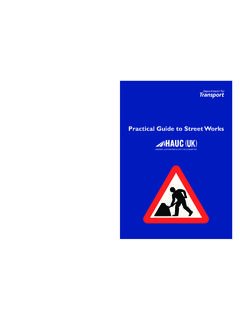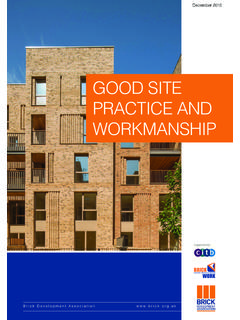Transcription of FIS Best Practice Guide - Libra Systems UK
1 BEST Practice Guide INSTALLATION OF SUSPENDED First edition published January 2012 This edition published April 2015 ISBN 978-0-9565341-2-5 World copyright reservedCopyright 2015 FISP ublished by FISNo part of this document may be reproduced or transmitted in any form or by any means electronic, chemical or mechanical, including photocopying, any information storage or retrieval system without licence or other permission in writing from the copyright every care has been taken to ensure the accuracy of the details presented in this document, we regret that FIS cannot be held responsible for any errors or omissions contained byThis project has been delivered with support from the CITB Growth Fund, which aims to ensure that the construction industry has the right people, with the right skills, in the right place, at the right time and is equipped to meet the future skills demands of the Practice Guide INSTALLATION OF SUSPENDED CEILINGS3 1 Foreword.
2 42 Introduction .. 5 Scope .. 5 3 Recommendations for tendering and measurement .. 6 Contract conditions .. 6 Basis of measurement .. 6 Programme .. 6 Main contractor (attendances) .. 6 General scaffolding .. 6 Specialist scaffolding .. 6 Unloading .. 6 On site storage .. 7 Temporary lighting and power .. 7 Working space .. 7 Waste management .. 7 Design requirements.. 7 Drawings for tender enquiry .. 7 Specification .. 8 Building owner inviting tender .. 84 Contract planning .. 9 Integration of ceiling related services.
3 9 Sequence of installation .. 9 Materials management .. 10 Site conditions .. 10 Setting-out points .. 10 Programme .. 105 Setting-out the ceiling .. 11 Setting-out and levelling .. 11 Tolerances of suspended ceilings .. 11 Top fixings .. 11 Hangers12 Installing a ceiling beneath an existing ceiling .. 13 Ceiling mounted light fittings / downlighters .. 13 Appearance .. 146 Suspended ceiling system types and installation procedures .. 15 Exposed grid Systems ..15 Concealed grid Systems .. 17 Acoustic infills for use in metal ceilings ..19 Stretch / tensioned ceilings.
4 19 Linear strip / screen ceilings .. 20 Raft / island ceilings .. 20 Fixed sized, pre-made rafts .. 20 Site constructed rafts .. 21 Acoustic baffle ceilings ..21 Access panels .. 22 Perimeter and transition trims .. 227 Suspended ceilings and fire .. 23 Structural fire resistance .. 23 Integrity of the grid assembly .. 23 Hold down clips ..23 Continuity of fire resistance .. 23 Cavity barriers .. 248 Contracting support administration .. 25 Sustainability ..25 Health and safety .. 25 Operation and maintenance manuals .. 259 Glossary .. 2610 Acknowledgements.
5 27 CONTENTS4 This Guide has been developed by FIS to promote best Practice in the installation of suspended are very few commercial building projects, new build or refurbishment, which do not have suspended ceilings as one of their key construction components. Usually representing the largest uninterrupted surface, they make a major contribution to the overall appearance and acoustic quality of the finished a platform for lighting fixtures, HVAC diffusers, sound Systems and wireless antenna panels, suspended ceilings deliver functionality to the building owner. For the construction team they offer a rapidly installed, dry and relatively clean , for the completed ceiling to meet the legitimate expectations of the building owner, occupier, design professionals and construction team, the selection and installation process must be carefully considered and understood by all ceilings are a finishing trade and require installation by specialist contractors.
6 The specialist contractor will provide the high levels of management, operative skills and resources, essential to deliver a high quality product. Their considerable experience on similar projects will be of significant assistance to the construction manufacturers design and produce engineered ceiling Systems , which are then tested to meet the requirements for various environmental and performance levels. The provision of a whole range of design solutions is part of the responsibilities taken by manufacturers, who have a key role to play in ceiling has grown over the past 50 years to become the leading trade association for the interiors fit out sector of the construction industry, representing companies involved in the manufacture, supply and installation of all aspects of interior fit out and refurbishment.
7 Its members can provide optimum solutions of the installation of interior FIS Best Practice Guide for the Installation of Suspended Ceilings is not intended as a definitive technical manual, as the manufacturers recommendations must always be followed, but as a Guide to the construction team as to best Practice . FIS encourages all its members to follow the principles set out in this A satisfactory suspended ceiling installation must fulfil three main requirements: Appearance Function (performance) Structural can only be achieved when the ceiling is installed under proper site conditions (see FIS Site Guide for Suspended Ceilings ), using the correct techniques, the right materials for the job, a high standard of workmanship and at all times adhering to health and safety should be noted that under no circumstances can the back of a suspended ceiling be considered a walkway or to accommodate cables ducts and trunking, which should be housed in appropriate trays, independently supported from the soffit.
8 If a walkway in the ceiling void is required separate provision must be SCOPEThis best Practice Guide covers the installation of all forms of suspended the practices described apply equally to ceilings which are intended to provide structural fire resistance, additional requirements may have been imposed to obtain the fire endurance classification of a particular floor-ceiling construction. Such details should be obtained from the manufacturer and approved by the client / professional team before the ceiling installation measures may be necessary to meet sound attenuation requirements when ceiling voids extend over adjacent rooms. This may involve the installation of sound attenuating barriers in the ceiling void or modification of the ceiling panels.
9 The advice of the manufacturer of the acoustic materials should be sought, together with reference to the FIS publication A Guide to Office Acoustics . In some cases the services of an acoustician may be To enable the specialist contractor to submit a realistic tender it should be informed of the items given below. Tenders should normally be submitted on the basis that the work is to be carried out continuously; hangers, grids and panels being fixed in one operation and the work completed during one visit to site. Should more than one visit be anticipated the tenderers should be informed CONTRACT CONDITIONSThe form of contract, for example JCT, NEC, or bespoke form, should be stated and the relevant sections of those contracts completed (contract particulars / contract data), which will include the following particulars.
10 Payments (ideally a list of due dates and final dates for payment) Retention (usually 3-5%) Discounts (it is preferable to have contracts placed on a nett of discount basis) Insurances Liquidated and ascertained damages Defects liability period (now called rectification period under JCT11) Programme (period and likely commencement date) Ascertainment of prices for variations Basis of day work charges Responsibility for design Requirements for bonds, warranties and parent company guarantees Waste Basis of measurementThe basis of measurement may take one of the following forms: Standard Method of Measurement 7th edition (SMM7) New Rules of Measurement (NRM) Quantities taken off drawings by the specialist contractor and expressed as a lump sum (plan and spec) or an inclusive price per square metre Site survey by specialist ProgrammeIn addition to the information given in , as much information as is available should be given to the tenderer regarding the main contractors building programme.










